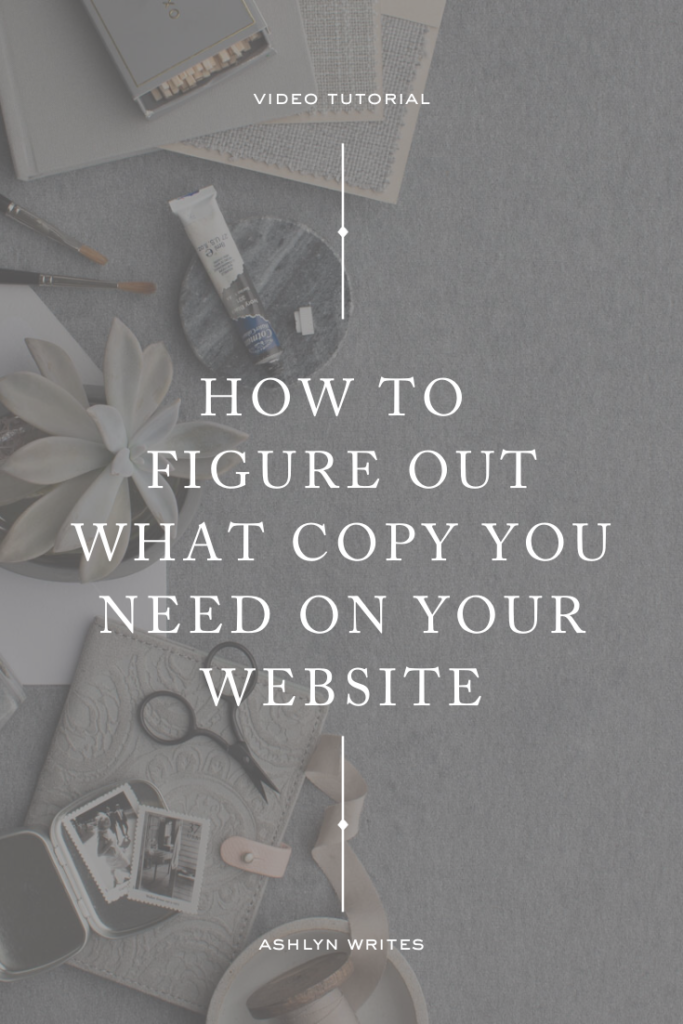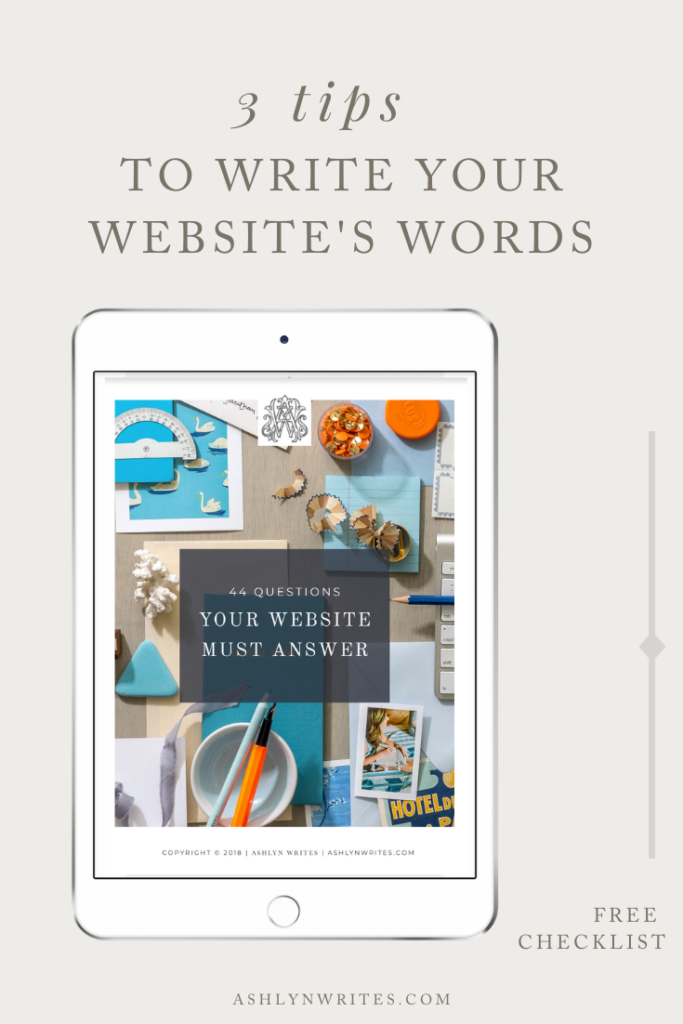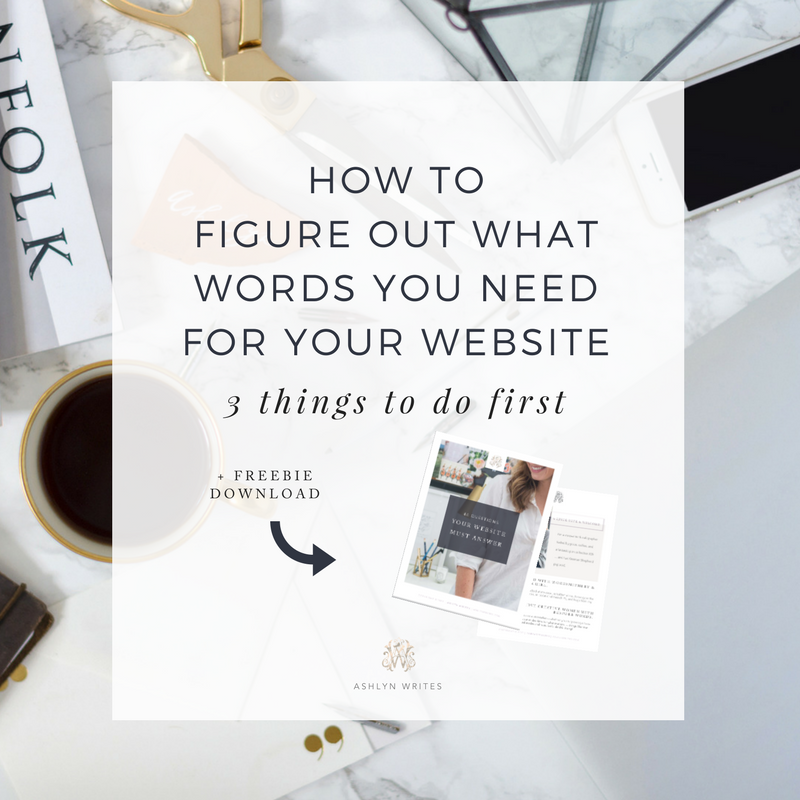Let’s talk about how to write your website … starting with a confession I need to get off my chest: on my 1 year business anniversary (coming up on 2 now), I drank champagne at my desk.
On a Wednesday.
At 11 a.m.
After 365 days tucked in the spare bedroom in our first home (I called it my “studio” to feel fancy), I learned—in a word—that God’s faithful. He delights in giving us specific gifting & talents, and while He doesn’t need us at all, He favors using us to serve others.
“You know those things you’ve always wanted to do?
You should go DO them.”
That was my drive pushing me to take a swing at leaving the corporate world to work for myself, and if it’s yours too, hear me loud and clear: you’re called to do something for a reason.
And if you’re like most creative women heading out on their own like I was a couple of years ago, image clarity, composition, editing? Check!
You have hex codes and gorgeous images, but … do you have a mood board for your words? Do you know what to put next to your images so you can make sales happen?
And writing a website for that budding little business you’re dying to start is no small feat.
I remember because I was there two years ago.

Like most good things in life, we learn best by just doing it, so I want to inspire you and prep you to stop chasing perfection and actually publish your website (or just get it to a place where you’re proud of its message!).
Before you sit down to write it all, here are 3 tips to get your head in the game and figure out what words you need for your website. I shared these with my sweet client Shay Cochrane of SC Stockshop and her audience this week, and wanted to pass them to you, too!
You’ll learn:
- The step you need to do first, that most creatives skip
- The 10 basic components of copy on the important pages of your website (lookin’ at you, work with me)
- 44 questions your website NEEDS to answer.
Read this before you write—then, download your freebie before you hit publish to make sure you rocked it!
Step 1: Never write without gathering your toolbox—starting with your brand messaging.
*Joanna Gaines reference coming, sorry ’bout it in advance.
Here’s the thing I tell my students and clients: you can’t tell people what you do if you don’t know how to say it yourself. We field a LOT of inquiries each day wonderful people wanting to work with us, but the problem in outsourcing copywriting is that you are POTENTIALLY outsourcing the psychological conversations about your offer that you need to be having yourself.
There’s an old communications saying:
“Tell ‘em what you’re going to tell ‘em… tell ‘em… tell ‘em what you told ‘em.”
And I wholeheartedly agree with that. But … you can’t tell them thrice if you can’t clearly state it yourself.
Think about Fixer Upper: Chip takes the house down to the studs before they get cranking on shiplap city. When you write on the fly, you’re likely slapping up words and not paying attention to the message at stake—not to mention the sales goals you need to hit to be a profitable business.
And if you’ve ever house shopped, you know quickly when you set foot inside: the ones that were renovated well and taken down to the studs, THOSE are the ones that pique your interest with their beauty.
As my realtor mother-in-law tells us, you can’t put lipstick on a pig.
TAKEAWAY TIP: Have your own demo day. Pour a fresh cuppa coffee, sit down, and pull your brand down to the studs by gathering (or writing out for the first time!) the following. This will help you be more thoughtful with your copy.
-
Mission statement
-
Core values
-
Elevator pitch
-
The unique selling proposition (I call this your “onlyness factor”) of your brand AND your offer
-
Word bank or brand voice statements
-
Your message and sales goals
Put. pen. to. paper.
Excavate your message first, so you can then clearly pass it off to someone else.
p.s. Oh, and memorize your elevator pitch. 🙂 I blogged about that over here if you need help explaining what you do!
Step 2: Figure out your goals & outline how you’ll guide your reader through your copy.
One of the biggest mistakes I see on websites is messaging that doesn’t guide your readers through an experience.
You slip into hostess mode when someone waltzes into to your website. Ever had a dinner party and needed to direct someone to your guest bathroom? Or needed to communicate that the big screen TV and friends are gathered out on the back porch, and it’s right-this-way? It’s important to start with the end in mind, and direct your reader.

Same on your website.
Figure out your goals, whether it’s what you need to sell and market the most (email list? photography package #3? free consultation?) or what they’ll do on each page.
How do I do this for our clients?
Just pleased as punch you asked! 😉
I make an outline, starting with the end in mind.
When I start writing a page for a client, I write “GOAL:” at the top of each GoogleDoc page. After I’ve verbalized what in tarnation I want them to do on that page of the website, I write an outline for my first draft (my second-grade teacher called them “sloppy copies,” and author Anne Lamont calls them “shi**y first drafts,” pick your poison.).
More or less, you’ll have approximately 10-ish elements on *most* pages:
- Headline
- Subheadline
- Intro
- Body copy or some more subheads
- Value proposition (my students and clients know I call this your Onlyness Factor) in there somewhere—the WHY you want them to buy into what you’re saying and promise of that offer
- Conclusion
- Call to action
- Plenty of Brand Voice
- Arguments
- Persuasion
So, I outline and try to hit those 10 things when I write a page.
Make mini-rough draft outlines—NO PERFECTIONISM ALLOWED—of the big pages (home, about, services, contact) before digging into the next section, which is super fun, I promise.
TAKEAWAY TIP: As you sit down and think through how to write a website, draft in a tool like Google Docs—not your website platform. Write “GOAL:” at the top of each Google Doc page. After you’ve verbalized what you want visitors to do on each page of the website, write an outline for your first draft. Want to see more about how we do that? Here’s a post (and template) on it.
Step 3: Pool what you like.
There’s no such thing as great writing. Only rewriting.”
With online businesses, know/like/trust is the name of the game.
What does this mean? You need to encourage readers to hear YOU through your copy. The more they “hear” you, the more likely they are to trust you.
Which brings me to swipe filing.
(I like to call it copy banking.)
One of my favorite things to do when I write a website—or even rewrite pieces of my own—is to grab markers, white paper, stacks of books and magazines, and a laptop.

I basically just drain my favorite voices—Ann Voskamp, Stephen King, Shauna Neiquist, The Atlantic, The Skimm, Southern Weddings, Artifact Uprising, Corinne Olympios’s Instagram captions (YES, like from The Bachelor. She’s a nut, and her captions are hilariously zany … one of my favorite copywriters listens to hip-hop for inspiration, so there’s no limit) etc.—for fun phrases and words.
And I write them all over sheets of white paper, making a word collage.
I also take it a step further and make swipe files in Evernote and Trello, which is something I lurve teaching inside my Copywriting for Creatives course.
After I make these virtual collages, I head back to my initial drafts and start cutting-and-pasting words and phrases into my rough copy. It’s a work-in-progress, but it helps me get on the right footing! You can pop over to this post to see a behind-the-scenes video of me pulling swipe file copy.
TAKEAWAY TIP: Grab markers, white paper, stacks of books and magazines, and a laptop. Pick out some favorite books, magazines, and websites (ahem—NOT in your industry!) and look for fun phrases and words. Write them all over sheets of white paper, making a word collage, and head back to your initial drafts. Start mixing and matching words into your rough drafts.
I sure hope that helps you get started writing a website for your creative small business—that’s a broad shakedown of what my team and I do before we get cranking on website copy, and how we instruct students to give it a whirl.
Ready to hit publish?
At the end of the day, ask yourself these 3 questions about your messaging & copy:
- Will it compel?
- Will it convert?
- Will it close?
‘Cause if it ain’t read, it’s dead. Period.
The internet changes on a daily basis, but it’s our job to learn how to write copy for our businesses that connects and converts, so we can reach our ideal clients online. SO—this is a bust if I don’t mention that every month, right at the top of the month, I run a Duty Day. I check in on copy, look at our heatmaps and stats, and mostly just make sure everything is working. Want to start your own Duty Day method? Here’s the scoop!
Have fun with it, share your story, and couple your brand imagery with words that further your relationship both on and offline.
LOVE THIS SLASH NEED IT BACK-POCKETED FOR LATER?
CLICK BELOW TO PIN IT!

Reading Time: 7 Minutes
Before you sit down to write it all, here are 3 tips to get your head in the game. and figure out what words you need for your website.
Read this before you write — then, download the 44 question checklist before you hit publish to make sure you rocked it!





Hello Ashlyn,
You know what, you are so good at what you do. It makes me so excited to hire you some time soon. lol!
I’d be honest, I hate reading words before. I hate researching words and blah blah. When I landed on your site, I figured out the right words for my branding. Believe it or not, I spent a week researching and compiling words (that i think is right for me) lol!
Talk soon!
That is so great, Mariel! My team and I are ready when you are! It’s such an encouragement to me when I hear from business owners who are finding the right words for their message. You’re doing big things, girl! xo. Ash
Hello,
I love everything about this, ace advice. I’d hit a total block of how and what to write on my website and even how to structure it – I’m so keen just to crack on with doing the do this has really helped to focus me and some superb top tips! Thanks a mill.
Julia
You are SO welcome, Julia! It makes me so excited to hear that you found this helpful. Best of luck girl! xx.Ash